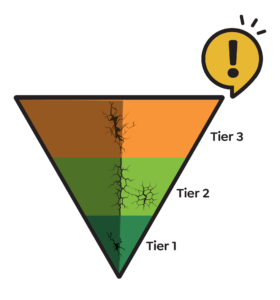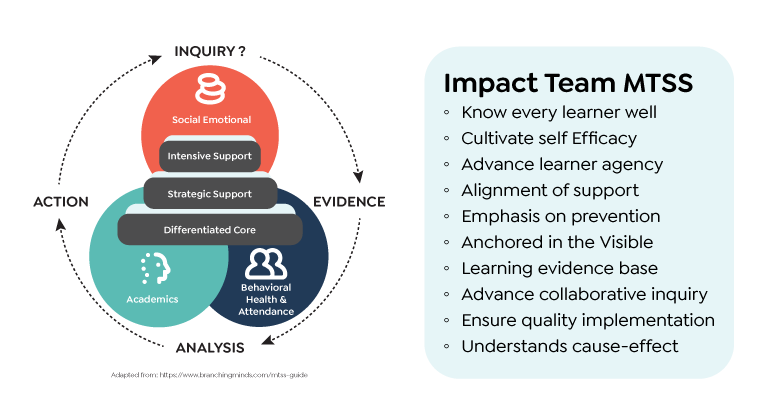 In an ideal Multi-Tiered System of Support (MTSS), the triangle is upright: Tier 1 supports most learners, Tier 2 provides targeted instruction for some, and Tier 3 offers intensive intervention for a few. But in many schools today, the triangle is inverted — and the system is straining under the weight of unmet needs.
In an ideal Multi-Tiered System of Support (MTSS), the triangle is upright: Tier 1 supports most learners, Tier 2 provides targeted instruction for some, and Tier 3 offers intensive intervention for a few. But in many schools today, the triangle is inverted — and the system is straining under the weight of unmet needs.
This isn’t a failure of students. It’s a sign that the system needs to shift.
The path forward isn’t just about catching kids up — it’s about building a mastery-based system that knows every learner, supports deep learning, and cultivates the dispositions needed to transfer knowledge with confidence.
Impact Team Steps to Success
In many schools today, the Multi-Tiered System of Support (MTSS) triangle is inverted, signaling a pressing need for change. The path forward involves shifting from a traditional, time-bound approach to a mastery-based system designed for deep, transferable learning. This transformation unfolds in six deliberate steps:
- Step One: Build a system rooted in personal connections and deep knowledge of each learner.
- Step Two: Define and center mastery learning to ensure all students reach high levels of understanding.
- Step Three: Reclaim and flexibly use time as an equitable resource to support mastery and agency.
- Step Four: Collaboratively set bold, clear goals with students as partners in their learning journeys.
- Step Five: Strengthen Tier 1 instruction through deliberate practice, formative assessment, and dispositional growth.
- Step Six: Reimagine Tier 2 as an integrated, strategic extension of core instruction to support prerequisite skills and dispositions, accelerating all students toward mastery.
 Step One: Build a System That Knows and Grows Every Learner
Step One: Build a System That Knows and Grows Every Learner
The foundation of any successful school system isn’t merely content—it’s an authentic connection. Designing for mastery begins with deeply knowing your learners, especially those who have historically experienced the greatest harm and continue to show the lowest performance. Mastery learning is not a one-size-fits-all journey; it requires educators to empathically understand each student’s strengths, interests, cultural identities, lived experiences, and learning dispositions.
This depth of understanding goes beyond traditional academic data. It means actively listening to students’ and families’ stories, particularly those from marginalized or underserved communities, observing learning behaviors with empathy, and genuinely honoring their voices in decision-making processes. Gathering data through empathetic methods—such as listening sessions, empathy interviews, and narrative storytelling—ensures that school practices align with and respond directly to the lived realities of students and families who have historically felt unseen or unheard.
When students and families feel genuinely seen, heard, and valued, learners are more likely to take ownership of their education, engage deeply, and persist through challenges. This kind of relational trust creates optimal conditions for risk-taking, meaningful feedback, and sustained growth—all essential components of a mastery-based system. Simply put, authentic connection is the gateway to high expectations, and empathetically knowing your students is the key to helping them reach their fullest potential.
To build a truly human-centered system:
- Implement empathetic data collection methods such as listening sessions and empathy interviews to better understand and respond to the experiences of students and families most impacted by systemic inequities.
- Use formative, holistic, and narrative assessments that highlight academic strengths, learning dispositions, and personal growth.
- Create comprehensive learner profiles inclusive of students’ cultural backgrounds, identities, aspirations, preferred learning strategies, and lived experiences.
- Develop robust feedback systems that affirm students’ efforts, acknowledge their growth, and encourage them to see themselves as capable and resilient learners.
- Embed structured advisory periods, relationship-building routines, and regular check-ins, ensuring every student is known and recognized by name, strength, and story.
When schools intentionally cultivate empathy and relational trust, students gain the confidence and support needed to pursue mastery and lifelong learning.
Step Two: Define and Center Mastery Learning
Mastery learning is the belief — and commitment — that every student can achieve high levels of understanding when provided with the right time, the right support, and the right opportunities to grow. It challenges the idea that learning should be bound by rigid timelines or pacing guides and instead centers the learner’s needs, progress, and potential. In a mastery-based system, mistakes are viewed as part of the learning process, not failure, and students are given multiple chances to reflect, revise, and improve. It’s a model rooted in equity, ensuring that success isn’t reserved for a few but made possible for all through intentional design, formative feedback, and a culture that values progress over perfection.
Instead of racing through content, mastery systems allow students to:
- Practice skills deliberately with scaffolding and feedback,
- Revisit concepts without penalty,
- Reflect and revise their work,
- And develop the dispositions — like persistence, curiosity, and self-regulation — that support long-term transfer.
Mastery is not just about knowing more — it’s about learning deeply, transferring knowledge, and becoming an agent of your growth.
Step Three: Reclaim Time as a Lever for Mastery and Agency
Time in traditional systems is often fixed — and unforgiving. But in a mastery-based system, time must flex to meet learners where they are and move them forward.
This looks like:
- Dedicated time for practice, reflection, and revision built into weekly planning,
- Flexible blocks like WIN (What I Need) time, re-engagement labs, or skill studios,
- Student-driven schedules where learners make choices based on evidence of need, and
- Regular time for feedback conversations between students and teachers.
Time is equity. When we give students the time they need to truly learn — and the tools to use it wisely — we honor their potential.
Step Four: Set Bold, Collective Goals with Students as Partners
Mastery systems thrive on shared goals and shared ownership. When teachers and students work toward a common purpose, anchored in clear learning intentions and co-constructed success criteria, it creates a sense of direction and unity. The clarity of where we’re going — and how we’ll know when we get there — fuels both engagement and self-efficacy, the belief that “I can do this” and “we can do this together.” As students experience success and track their own growth over time, they build the confidence to take on more challenging tasks, persist through struggle, and see themselves as capable, empowered learners.
- Every PLC or Impact Team should identify one focused learning goal per cycle, aligned to a priority standard and a key disposition for transfer.
- Students must be partners in setting and tracking learning goals, building self-efficacy and a sense of progress.
- Success criteria should be visible, co-constructed, and actionable, allowing learners to reflect and revise meaningfully.
When students co-own their learning journey, school becomes more than a place they go — it becomes a path they help design.
Step Five: Strengthen Tier 1 with Deliberate Practice and Assessment for Learning
A mastery system starts with Tier 1 — but not just as a place to deliver curriculum. It must become a space for deliberate practice, student-centered assessment, and dispositional development that cultivates the skill, will, and thrill needed for learning transfer. However, transforming Tier 1 is complex and takes time. It requires deep collaboration, shifts in mindset, redesigning instruction around formative assessment and feedback, and building teacher capacity to implement culturally responsive, asset-based pedagogy.
That’s why, in schools where the triangle is upside down, you often have to begin by strengthening Tier 2 first — as a major triage system. Tier 2 becomes both a safety net and a springboard, offering immediate, targeted support to students who need time and structure to build prerequisite skills and learning dispositions. While Tier 1 is under construction, Tier 2 helps stop the bleeding, stabilize the system, and create momentum toward a future where all students can thrive in a truly mastery-based environment.
That means:
- Designing weekly learning intentions tied to essential standards and learning dispositions (e.g., perseverance, collaboration, reflection).
- Embedding daily formative assessment to surface what students know, what they need, and how they’re progressing toward mastery.
- Creating conditions for deliberate practice (Ericsson) — where students engage in focused repetition, receive timely feedback, revise, and try again.
- Empowering students to co-construct success criteria, self-assess, and set personal learning goals.
Skill alone is not enough. Students must build the will and thrill (Hattie & Timperley) — the motivation and joy — to pursue learning with agency and purpose.
Step Six: Reimagine Tier 2 to Support Prerequisite Mastery and Dispositional Growth
When many students need support, Tier 2 cannot be a silo — it must be an integral part of a cohesive learning system. Instead of being a place where students are pulled out and patched up, Tier 2 should function as a coherent extension of Tier 1, directly aligned to core learning intentions and success criteria. It must be designed to accelerate students toward mastery, not pull them away from it, offering high-impact, small-group instruction that reinforces essential skills while nurturing learner agency and confidence. When Tier 2 is grounded in deliberate practice, assessment for learning, and dispositional growth, it becomes a powerful lever for equity and momentum.
One powerful model is Walk-to-Learn, where:
- Students are grouped flexibly based on current needs (not static labels),
- Instruction targets prerequisite skills and learning strategies aligned to Tier 1 goals.
- Time is protected for deliberate, guided practice and feedback, and
- Students build academic capacity and learning dispositions, like focus, reflection, and resilience.
Tier 2 becomes a space for catching momentum, not just catching up. It’s where students rehearse success.
From Inversion to Innovation: A System That Serves All Learners
An upside-down triangle doesn’t mean your school is broken — it means your system is asking for something better. It’s a signal that the traditional structures and timelines aren’t meeting the real, diverse needs of your learners, and that it’s time to think outside the box. Rather than doubling down on what’s not working, it’s an invitation to design with your students at the center — their strengths, cultures, identities, and aspirations. It calls for bold, innovative thinking: reimagining time, reworking support systems, and reshaping instruction to create a learning environment where every student has a real shot at mastery. It’s not about fixing kids — it’s about fixing systems, and building something more human, more equitable, and more effective than what came before.
By:
- Centering relationships and whole-child understanding as the foundation,
- Defining mastery learning as the goal for all learners,
- Partnering with students in goal-setting and reflection,
- Reclaiming time as a tool for equity and agency,
- Using Tier 1 as a space for deliberate practice and assessment for learning,
- Elevating Tier 2-3 with flexible, targeted, asset-based support,
…you don’t just flip the triangle. You transform the experience of school.
This is how we move from compliance to confidence. From coverage to transfer. From “how far behind” to how far we can go — together.


